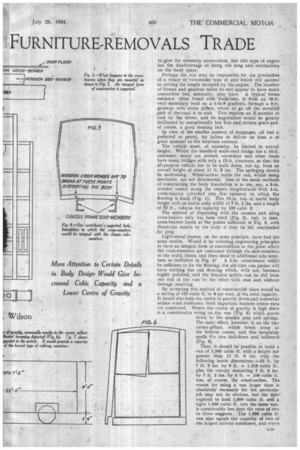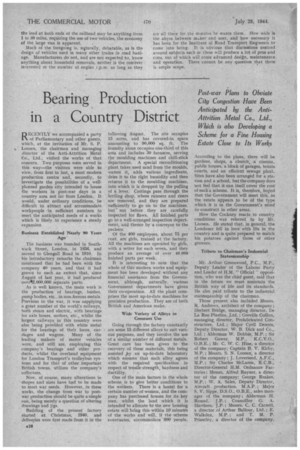THE VEHICLE NEEDED BY TH FURNITURE-REMOVALS TRADE
Page 26

Page 27

Page 28

If you've noticed an error in this article please click here to report it so we can fix it.
THE furniture-removals trade, between the wars; was one which, due to economic and other conditions outside the scope of this article and the ease with which removals could be accomplished by road transport, had grown to be an industry employing a large number of men and vehicles. It was, moreover, well led and governed by its own association, the N.A.A.F.W.R.
Prior to the 1914-1918 war removals methods were to use horsed pantechnicons for local jobs and for mileages up to 20 and 30. For greater distances the lift van, of some 600 cubic-ft. capacity was used, in conjunction with rail.
After the war of 1918, and the advancement of road transport, the lift van was employed in conjunction with a solid-tyred platform lorry, which hauled a platform trailer with a second lift van on it. This proved to have so many advantages over rail that long-distance removals by road became an every-day occurrence. The ratio of pay-load to unladen weight was, however, out of all proportion, the average pay-load of some 2i tons comparing with an unladen weight of from 4 to 5 tons, plus 15 cwt. to 1 ton for the lift van.
The next step was the building of pantechnicons on commercial-vehicle chassis, the capacity starting at about 800 cubic ft., and rising, through the years, to a maximum, on a four-wheeled chassis 01 approximately 1,500 cubic ft. The 21-ton SO m.p.h. regulation brought an enforced standardiza,tion on this type of vehicle of about 1,000 cubic ft., so that, to-day, apart from the lift van, which will always be used for such jobs as shipping, etc., and for which any platform lorry is suitable, the main capacities, in general use, range from 1,000 to 1,500 cubic ft.
It is, indeed, surprising that, during the years of change in bodywork, no commercial-vehicle chassis has been expressly adapted for the removals trade. Any variations carried out at the operator's request have, largely, ignored engineering principles and, significantly enough, usually annul the maker's guarantee. Under war-time restrictions all long-distance removals work has gone back to railways and has shown, as never before, the shortcomings of this method of haulage.
Lack of crane power at many of the smaller stations, and the time factor on anybut the main lines, are two of the many factors which have nothing to do with war conditions. Nevertheless, the railways will do everything in their power, after the war period, to retain this class of traffic and, to counter this, removals contractors will require, amongst other things, the right vehicle for the job.
The chassis of the maximum-capacity all-purpose vehicle should be a four-wheeled, long-wheelbase type designed for drawing a trailer and to come within the overall length of 26 ft. The carrying capacity should be about 7 tons, which will bring the unladen weight of the vehicle to under 5 tons. Many of the removers, and the country, generally, have suffered during the present war through the inability of the lighter vans to carry tonnage. •
The engine should be powerful enough to give a high-average road speed, particularly where the gradient rises several hundred feet in 20 or 30 miles. This applies to many of our coastal towns and many more situated on opposite sides of hill ranges. Obviously, the time factor becomes a serious matter when a vehicle grinds its way up a long gradient at from 3 to 5 m.p.h. Where that condition obtains, a driver is tempted to exceed the speed limit on the down gradients, often finishing up by being caught for speeding or by an accident.
One of the advantages of road over rail is that a family may arise in the morning in one house and go to bed in their new house at night. The main factors governing the maximum possible mileage between the two houses are the power-output of the engine and the gear ratios. Only a six-cylindered job seems
to give the necessary acceieration, but this type of engine has the disadvantage of being too long and encroaching on the body space.
Perhaps the war may be responsible for Lho production of a rotary or two-stroke type of unit which will succeed in cutting the length occupied by the engine. The location of houses and gearbox ratios do not appear to have much connection but, naturally, they have. A typical house entrance. often found with variations, is from an 18-ft. very secondary road on a 1-in-9 gradient, through a 9-ft_ gateway with stone piffars, where to go off the metallett part of the&road is to sink. This requires an X-number of cuts by the driver, and its negotiation would be greatly facilitated by exceptionally low first and reverse gears and, of course, a good steering lock.
In view of the smaller number of stoppages, oil fuel is preferred to petrol, for failure to deliver on time is of great moment to the furniture remover.
The vehicle must, of necessity, be limited in overall height. Whilst the standard main-road bridge has a 14-ft. clearanee, many are arched; secondary and other roads have many bridges with only a 12-ft, clearance, so that the all-purpose vehicle has to be built down, not up, from an overall height of about 11 ft. 9 ins. The springing should be underslung. Wheel-arches inside the van, whilst being inevitable, are not detrimental. One of the usual methods of constructing the body foundation is to use, say, a 6-in. wooden runner along the chassis longitudinals with 4-in. cross-bearers (checked into the runners) to which the flooring is fixed (Fig, 1). This 10-in. loss of useful body height with an inside oody width of 7 ft. 2 ins, and a length of 22 ft., reduces the capacity by ISO cubic ft
The method of dispensing with the runners and using cross-bearers only has been tried (Fig. 2), but, in time, cross-bearers break at The points indicated in Fig. 3, with disastrous results to the body if they be left unattended for long.
Light-metal frames, on the same principle, have had the same results. Would it be violating engineering principles to have an integral form of construction at the point where the cross-members are continued through the side-members to the width limits, and there fixed to additional side mem bers as indicated in Fig. 4? A I-in, cross-bearer would be sufficient to fix the flooring; the old-time van packer will have nothing but oak flooring which, with use, becomes highly polished, and the heaviest article can be slid from one end of the van to the other -with ease and without damage resulting.
By accepting this method of construction there would be a saving of 120 cubic ft,. or 8 per cent, of the total capacity. It would also keep the centre of gravity clown and somewhat reduce wind resistance. both important features where vans are concerned. Where the centre of gravity is high there is a considerable swing on the van (Fig. 5) which passes down to the shackle pins and springs. The main effect, however, is on the rear cdrner-pillars, which break away at
the bottom corner, and this invariably spoils tl-e two half-doors and tailboard (Fig. 6).
Thus, it should be possible to build a van of 1,500 cubic ft. with a height not greater than 11 ft. 9 ins, with the following inside dimensions:---22 ft. by 7 ft, 2 ins. by 9 ft. se. 1,419 cubic ft., plus the canopy measuring 3 ft. 9 ins. by 7 ft. 2 ins. by 4 ft. = 109 cubic ft. less, of course, the wheel-arches. The reason for using a van larger than is absolutely necessary for the particular job may not be obvious, but the time required to load 1,000 cubic ft. and a tight 1,500 cubic ft. into the same van, is considerably less than the ratio of two to three suggests. The 1,500 cubic ft. van also equals the capacity of two of the largest railway containers, and where the lead at both ends of the railhead may be anything from a to 30 miles, requiring the use of two vehicles, the economy of the large van is apparent.
Much of the foregoing is, niturally, debatable, as is the design of vehicles used in many other trades in road haulage. Manufacturers do not, and are not expected to, know anything about household removals, neither is the remover interested in the number of engine r.p.m. so long as they
are all there for the minutes he wants them. How wide is the abyss between maker and user, and how necessary it has been for the Institute of Road Transport Engineers to come into being. It is obvious that discussions centred around subjects such as these will produce a lot of pros and cons, out of which will come advanced design, maintenance. and operation. There cannot be any question that there is ample scope.




















































